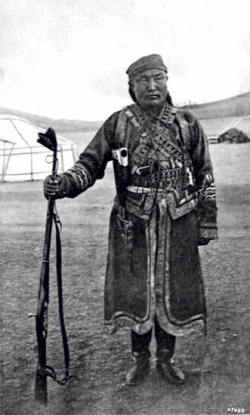Non-Human Origins of Dambijantsan
Given the mystery surrounding his birthplace, his age, and many of the subsequent events of his life it is perhaps to be expected that in Mongolia a supernatural version of Dambijantsan Mythologem would eventually arise. This tale was told to me by a well-known and highly respected lama in Ulaan Baatar. When this lama’s teacher was a young man he had as his own teacher a lama who as a boy had lived with his parents at Dambijantsan’s Final Stronghold in the Black Gobi Desert in what is now Gansu Province, China. This lama related that Dambijantsan, despite his ferocious demeanor, liked to play with children. On sunny afternoons he would sit down outside, take off his shirt, and let a whole passel of small children climb over his body and hang on his neck. One day while horsing around in this manner our informant noticed that Dambijantsan had no belly button. He did not realize the significance at this at the time, but later he heard stories about beings who did not have belly buttons because they had not been born to a human mother and were not human beings themselves. Later in life this man came to believe that Dambijantsan was not actually a human being.
My own informant explained to me that this belief in entities who only appear to be human beings is fairly widespread in Mongolia. The telltale sign is the lack of a belly-button and the inevitable uncertainty surrounding the being’s family and origins. In the past such appearances were uncommon, but they did happen, he claimed. According to persistent rumors, Dondovdulam, the first wife of the Eighth Bogd Gegeen, was one of these non-human entities (this is of course hotly disputed by those who claim she came from an ordinary family at Baldan Bereeven Khiid). So what are these entities, and from where do they originate? As best my informant could explain, they are thought forms which have been manifested as material objects in the three-dimensional world by some power or force, the exact nature of which is unknown to us. They are created to accomplish some specific task, the ultimate goal of which is not always clear to human beings. As manifested entities, these beings lack the life story of a human being.
Thus the tales about Dambijantsan’s birth in Kalmykia, Inner Mongolia, Outer Mongolia, China, or elsewhere were blinds, perhaps created by in part Dambijantsan himself, to hide his true, non-human origins. The uncertainly over his birth date; the observation by some that he did not appear to age over time; the magical acts for which he later became famous, his alleged immunity to bullets and the belief, widespread during his lifetime, that he could never be killed by ordinary means were all a result of his non-human origins. Even the fact that he was eventually killed is tempered by the belief on the part of some that his material body was allowed to be destroyed because it was no longer of use to its creators but that his thought form continues to exist into the present. It might be added in conclusion that these entities no longer appear in material form in Mongolian today, mainly because the powers which produce them have disappeared or are at least in abeyance, but that in the future they may well occur again.
I do not present this theory here necessarily because I believe it; I do so only to demonstrate the incredible breadth of the tales which have accrued around the life of Dambijantan and which continue to be believed by at least some people down to the present day. But when these tales, bizarre as they may seem, are told by the light of a campfire at One of Dambijantsan’s Former Haunts, deep in the Gobi Desert eighty miles from any other human beings, they are not so easily dismissed.
